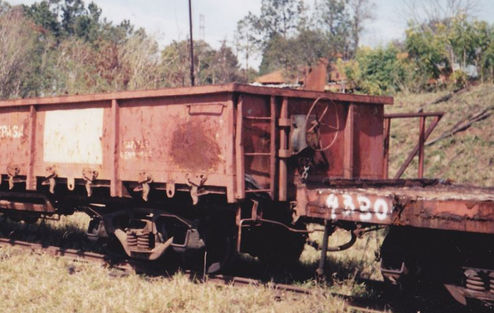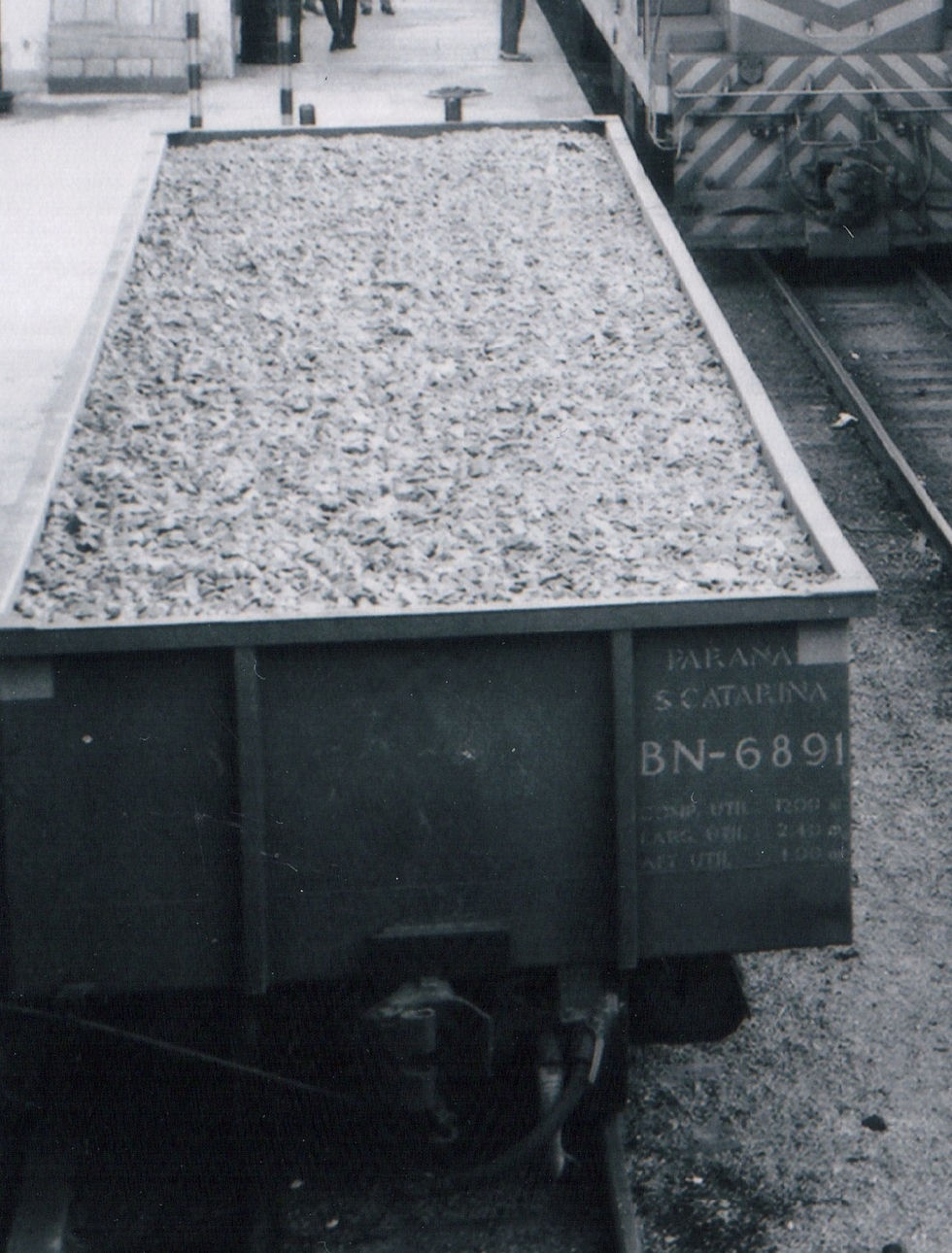Santa Matilde GFC Drop Bottom Gondola
METRIC GAUGE GONDOLAS:
The Drop Bottom Gondolas.
Transporting bulk material has always proven challenging for railways. The gondola car is a specialization in this sense. Its origins in Brazil date back to the beginning of railways. Companies usually adapted small spikes and slats in the platform wagon stanchions to build an edge to the wagon. This is why many of these companies did not use the term gondola, but rather “edge” for this type of wagon until the 1960s/1970s.
Obviously this wagon was not very popular with railway workers and customers because it required too much work (and downtime) to be unloaded, since all cargo had to be lifted over the edges and thrown out of the wagon with shovels. An attempt to solve this scourge was wagons with falling edges, that is, gondola wagons whose sides can be opened and positioned below the wagon's floor level. The most common models of this type of wagon were undoubtedly the 4 GTQ models in the São Paulo broad gauge and in the metric gauge the GTB manufactured by FNV for several railways and later GTC and GTD models, manufactured entirely in metal, for RFFSA and Fepasa. The problem of discharge, however, was not yet entirely resolved.
Drop Bottom Gondola Wagon after completion of gravity unloading. The remaining material, in the latter case, must be unloaded manually using shovels and hoes.Collection: APFMF Curitiba.
The development of the rolled steel industry and the national railway industry in the 1950s made it possible for us to manufacture more complex wagons in the national territory than generic closed wagons and planks. The industry begins to make wagons available with the Drop-bottom system. That is, trapdoors installed on the floor of the gondola that allow opening at the destination of the load and allow its unloading to be done by gravity, and only assisted by shovels.
Part of the mechanical project of a Drop Bottom Gondola, MPF Sorocabana collection
Example of a gondola with Drop Bottom doors, where we can see its open position. The door on the left, which represents the door at the ends of the wagon, opens less due to the limited size of the bogies. The one on the right represents the central doors, which open at a much greater angle, providing faster unloading. This is a limitation of the drop bottom concept.
A new Brazilian economic situation of industrialization also ensures perennial domestic production (and its demand for transport) and allows railways to begin specializing their fleet. Fixed edge gondola wagons are now required to transport not only bulk material such as ballast, sulfur, bauxite (main raw material for aluminum) and iron ore, but also pipes, metal profiles, shackles, national and imported mineral coal.
Santa Mathilde 1957, the pioneer.
Companhia Industrial Santa Mathilde responds to this demand with the 60t Drop Bottom gondola wagon, a classic of this generation, which today we call GFC using the ABNT nomenclature.
A success for the time, at least 520 units of this type were confirmed for the most diverse railways such as Leopoldina, Central do Brasil (metric), Paraná-Santa Catarina, Sorocabana, Mogiana and later for the Northwest of Brazil.
With very modest dimensions, it could easily travel on any meter gauge railway in the country. Its differentials were an all-sheet metal floor, automatic compressed air brake (Wabco), “Peerless” shock and traction device and “Alliance no. two". Originally all GFC Santa Mathilde from 1957/8 were built with a “post” model manual brake and Self Allign or Ride Control A-3 bogies equipped with “hot box” bearings with spring covers.
View of a GFC still in RFFSA numbering prior to SIGO, where we can see the still original rolling bearing tricks with spring cover.
The load of logs from this train was destined for Klabin do Paraná.
Santa Mathilde modernized 1970
As the railway industry evolved and some equipment standards were adopted by both RFFSA and Fepasa, in a mutual effort of rationalization and exchange, several wagons in this series underwent modernization. The most notable are the exchange of the direct “post” manual brake for the manual ratchet brake, which is lighter and safer to operate. This modification was made to practically the entire Fepasa fleet and to some RFFSA wagon units.
Comparison between manual brake actuation systems. On the left, the post-type brake in a photo by Davi Boçon and on the right, a ratchet, in a photo by Diego Bini.
And the replacement of rolling bearings with “cartridge” cartridge bearings, seeking to extend the maintenance cycle of the wagons and eliminate the need to control and supply lubrication to the bearing pads. According to this criterion, RFFSA modernized all the wagons that we had access to photos of before privatization, while at Fepasa there were still some (a few) with hot box bearings until the end. Understanding the modeler's needs, Marumbi Modelismo offers two models of this gondola, the original 1957 version with closed bearing covers and manual post brake (link), as well as the modernized “1970s” that comes with enclosed bogies and manual ratchet brake. . (link)
Typical example of the modernized version, with ratchet brake and cartridge bearing. Photo Fábio Dardes, 80s.
The use of drop bottom gondolas proved to be so interesting for the railroads that owned them that all that had the Santa Mathilde 1957 (GFC) subsequently acquired wagons of the same type with greater capacity, as we will discuss in the GFD and GPD gondola Masterclass. Even after 40 or more years of service at the time of privatization, between 1997 and 1999, dozens of these wagons were still in active service or were capable of renovation. The Ferrovia Sul Atlântico, Ferroban, Novoeste and Ferrovia Centro Atlântica received wagons of this model and many of them operated for up to another 15 years in secondary or permanent track maintenance trains, as we will discuss later.
Modeling:
Paint Schemes:
Marumbi Modelismo started offering decals for its wagons, and below we will demonstrate the main possible paint schemes to do on each of the wagons.
Cia Mogiana de Estradas de Ferro.
Photo crop of Sérgio Martire, ballast train during the construction of the Paulínia-Boa Vista connection in 1972.
For this paint schemewe recommend the original model, 1957.
In Mogiana, they were mainly used in the flow of bauxite from Minas Gerais to the CBA in Alumínio/SP. Remarkable use in ballast, consolidating permanent routes in a period of major renovation of the Mogiana network and the beginning of Fepasa (as shown in photo). Its use was throughout the network, along with the tipping gondolas.
Estrada de Ferro Sorocabana.
In Sorocabana, gondolas were widely used throughout the network, as in this photo with a general freight train, together with a tipping gondola. Special emphasis on these photos of Santa Matildes operating in Tronco Sul near Rio Grande do Sul, far from Sorocabana. This demonstrates the versatility and scope of use of these wagons throughout the national network in the 1960s and 1970s.
For this paint scheme we recommend the original model, 1957.
Ferrovia Paulista S/A.
FEPASA version “Phase 1”
GFC wagon still with the inscription “fepasa” in 1997, photo by Diego Bini in Iperó.
For this paint scheme we recommend both the original model, 1957, and the modernized model, 1970s. It is up to the modeler to analyze the wagon he wants to model on a case-by-case basis.
FEPASA version “Phase 2”
Fepasa's GFC wagon already modernized, photo by Fábio Dardes.
For this painting we recommend the modernized model, 1970s.
As far as we know, no GFC has received Fepasa's gray paint scheme.
Rede Ferroviária Federal S/A (generic, various regional)
RFFSA Operational Division Version (1957 - 1984)
Original painting of the gondolas, still without the RFFSA logo that would only be applied in the early 1970s.
Note that the drop bottom gondola is next to several other topples. Photo José Petroski / Correio dos Ferroviários.
For this paint scheme we recommend the original model, 1957.
RFFSA Version after SIGO (1984-1994)
GFC in the 80s with painting with the RFFSA logo and review board (colored rectangles on the right side). Note the inscription “Permanente Pedreira Roça Nova”.
At that time, many GFC were already captive to the permanent route. APFMF Curitiba Collection.
For this paint scheme we recommend both the original model, 1957, and the modernized model, 1970s. It is up to the modeler to analyze the wagon he wants to model on a case-by-case basis.
RFFSA “Phase 2” version (1997-1997)
GFC bearing the latest visual identity of RFFSA, with the logo before the acronym, photo in 1998. ABPF-PR Collection.
For this paint scheme we recommend both the original model, 1957, and the modernized model, 1970s. It is up to the modeler to analyze the wagon he wants to model on a case-by-case basis.
Estrada de Ferro Madeira - Mamoré.
For this painting we recommend the original model, 1957. Col. Davi Boçon.
There is also at least one GFC at EFMM, in Porto Velho/RO. It has not yet been possible for us to determine whether it is an own purchase from EFMM or whether it is transferred from some RFFSA region by DNEF.
As demonstrated above, GFC gondolas circulated throughout much of the country's meter gauge network during the state era. Its structure, as well as its “Alliance #2” couplings and “Peerless” shock and traction device, became weak and showed cracks due to use in longer and heavier trains, with some GFCs receiving “Full size” couplings or other modernizations. Years of use, combined with the purchase of larger and more modern wagons, relegated the GFCs to secondary services, with some GFCs being escalated to a second life, mainly in the early years of América Latina Logística, destined for smaller capacity lines in log trains.
Post Privatization
América Latina Logística
ALL's GFC in 2010, already adapted for the transport of logs, featuring full-size couplings and bearing ride control bogies. Photo: Jean Carlos Kuester.
Loads
In an open wagon like the GFC, it is always important to also think about the load. We are unable to post photos of all the loads that this wagon eventually transported, so we only have a few examples of loads, lashings and organization.
Logs
Photo Alfredo Rodrigues.
Scrap
Permanent way disposal material.
Photo Daniel K Trevisan.
Sand for internal railway use.
Photo A. Fressatto.
Machines tarpauled by FSA/ALL in 1999.
Limestone as EFS in Votorantim/SP
Photo crop by Paulo Modé.
Metal stamping shavings.
Photo from Fepasa Yearbook.
Fepasa ballast in Presidente Altino
Photo by Wanderley Paulini. (Fepasa)
Ballast by RFFSA in Morretes
Photo crop of the Social Communication Secretariat-5 of RFFSA
Marumbi Modelismo Drop Bottom Gondolas feature:
-
Project carried out based on the manufacturers' original mechanical drawings and measurements taken in the field.
-
Faithful, fully detailed interior and chassis
-
Plug-n’-play hitch box for kadee “scale” #158 or #153
-
Trucks that accept Locohobbies, Intermountain, Kadee or any other NMRA wheelsets.
-
Precise decals drawn on photos and graphic designs of the original typologies.
-
Various numbers per painting.




























